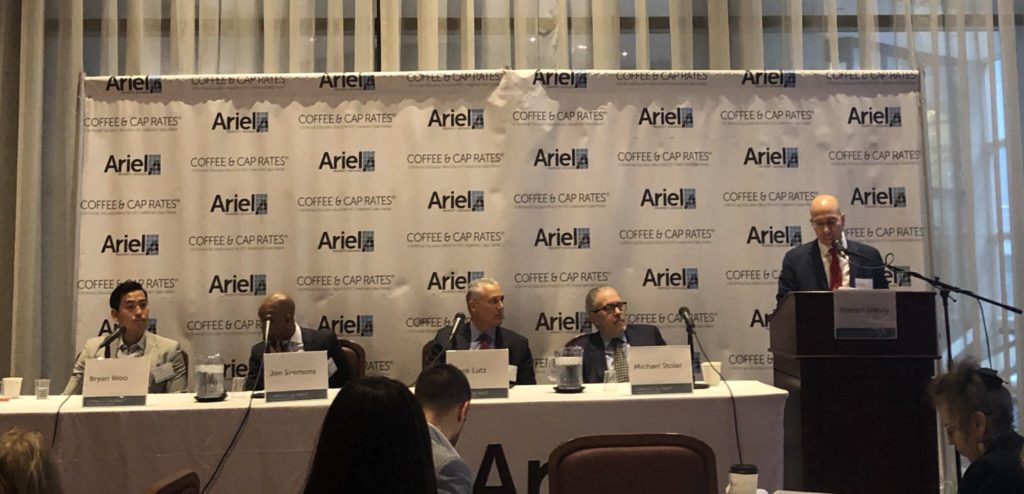NYC Multifamily Market to Experience Slow but Stable Growth in 2019

New York City’s multifamily market had a strong 2018, with robust investment volume and a number of large deals transacted. Yet a myriad of factors, including interest rate volatility, regulatory uncertainty and concerns about a market correction, likely mean a slower, but still stable, multifamily market performance in 2019. Panelists at Ariel Property Advisor’s recent Coffee & Cap Rates℠ event in New York City reflected on the city’s rental market performance in 2018, as well as the factors and trends set to impact the sector this year.
Large Transactions Spurred High Transaction Volume
NYC reached $11.4 billion in multifamily transactions in 2018, a 55% increase from the prior year. This volume was largely driven by high-price deals over $250 million, Ariel Property Advisors President Shimon Shkury noted. These deals included the $416 million sale of 101 West End Ave. in Manhattan and the $905 million purchase of Brooklyn’s Starrett City. Out of the five boroughs, only the Bronx had lower dollar volume year-over-year.
Other sectors, including office, also benefited from high-profile transactions in 2018. These included Google’s $2.4 billion purchase of the Chelsea Market building in Manhattan and Vanbarton Group’s $701 million buy of 425 Lexington Ave.
Increases in Treasury yields and interest rates in 2018 impacted mortgage pricing, despite going back down a bit early this year. As a result, cap rates began to stabilize across the city and have been ticking up in Manhattan and Brooklyn, leading to some pricing pressure. Price per square foot stayed flat in most of the boroughs. Manhattan saw a 7% decrease while the Bronx experienced a 9% increase, Shkury noted.
Trends Driving the Multifamily Sector
Panelists also discussed the market trends set to impact the apartment sector this year. One much-discussed driver was the Opportunity Zones program. The program was created to spur economic activity by offering tax incentives to investors who acquire and improve properties in underserved areas. There are 514 Opportunity Zones in New York State, and many are in the five boroughs, Shkury noted.
He added that these areas are likely to see more investment and development activity this year and will impact the city’s overall transaction volume and pricing.
While several panelists are or will be investing in Opportunity Zones, speaker Bryan Woo, Executive Vice President at Youngwoo & Associates, noted that “there’s a lot of ambiguity out right now about what you can and cannot do…our thought is to stay simplistic until regulations tell us otherwise.”
Right now, his firm is focused on what has proven to be a successful model of buying a single building, improving and stabilizing it, and then holding it for the 10 years so that they can capitalize on the benefits of the program.
Shkury also noted that technology will continue to impact the apartment market. While Amazon is no longer bringing its HQ2 to NYC, Facebook and Google’s recent investments are “positively affecting the market” and are a “critical element in New York City.” Co-working companies like WeWork and co-living will also contribute to the growth of the residential market, he said.
NYC Multifamily in Absorption Mode
As NYC’s apartment market continues to deal with the influx of new supply developed throughout this expansion, “the rental market is still in absorption mode,” Shkury observed.
This year, 25,000 units are expected to come online in Manhattan below 96th Street, Brooklyn, Long Island City and Astoria, which will result in further rental concessions and flat net effective rents.
This trend, combined with uncertainty regarding the city’s rent regulations that are up from renewal this June, has made for less transactions so far in 2019. This slower pace will likely continue until there is clarity on the new regulations, Shkury noted.
Affordability Remains an Issue in NYC
Despite a plethora of new supply, there is still a great need for affordable housing in the city, noted panelist Frank Lutz, Arbor’s Executive Vice President, Chief Production Officer.
“When you look at the cities where there is tremendous growth and tremendous economic prosperity, that’s where you have the most amount of pressure on affordable housing and where you see the greatest government effort to try to do something about it,” he said.
Fellow panelist Jim Simmons, managing partner of Asland Capital Partners, suggested that a good strategy to deal with affordability issues is for property owners and the city to work together to preserve the long-term affordability of a building in exchange for some tax benefits to the owner.
“For those groups who can do that, I think there’s more of that to come and hopefully we’re one of them,” he said.
Lutz emphasized the importance of this strategy, especially with the Opportunity Zones program in place, to ensure current residents aren’t pushed out.
He added that another way to support affordable housing is by investing in small apartment properties. Arbor has been active in the small loan space as a licensed seller/servicer of Fannie Mae and Freddie Mac’s small multifamily loan programs, Lutz noted. He added that the agencies’ programs have brought much-needed liquidity to the small loan space.
In addition to affordable housing, high-quality senior housing is another aspect of multifamily that’s growing in demand. Woo noted that demographics support the sector, as the overall population is aging and older people want a better quality of life. Today’s seniors are looking for access to amenities like top-rated healthcare and public transit, as well as activities like retail and restaurants.
Seniors tend to be long-term renters with reliable incomes, which is also attractive to investors and property managers, Simmons said.
“All of these factors mean that people are changing the way they spend their golden years and that senior housing is a great place to invest up and down the spectrum,” he added.

